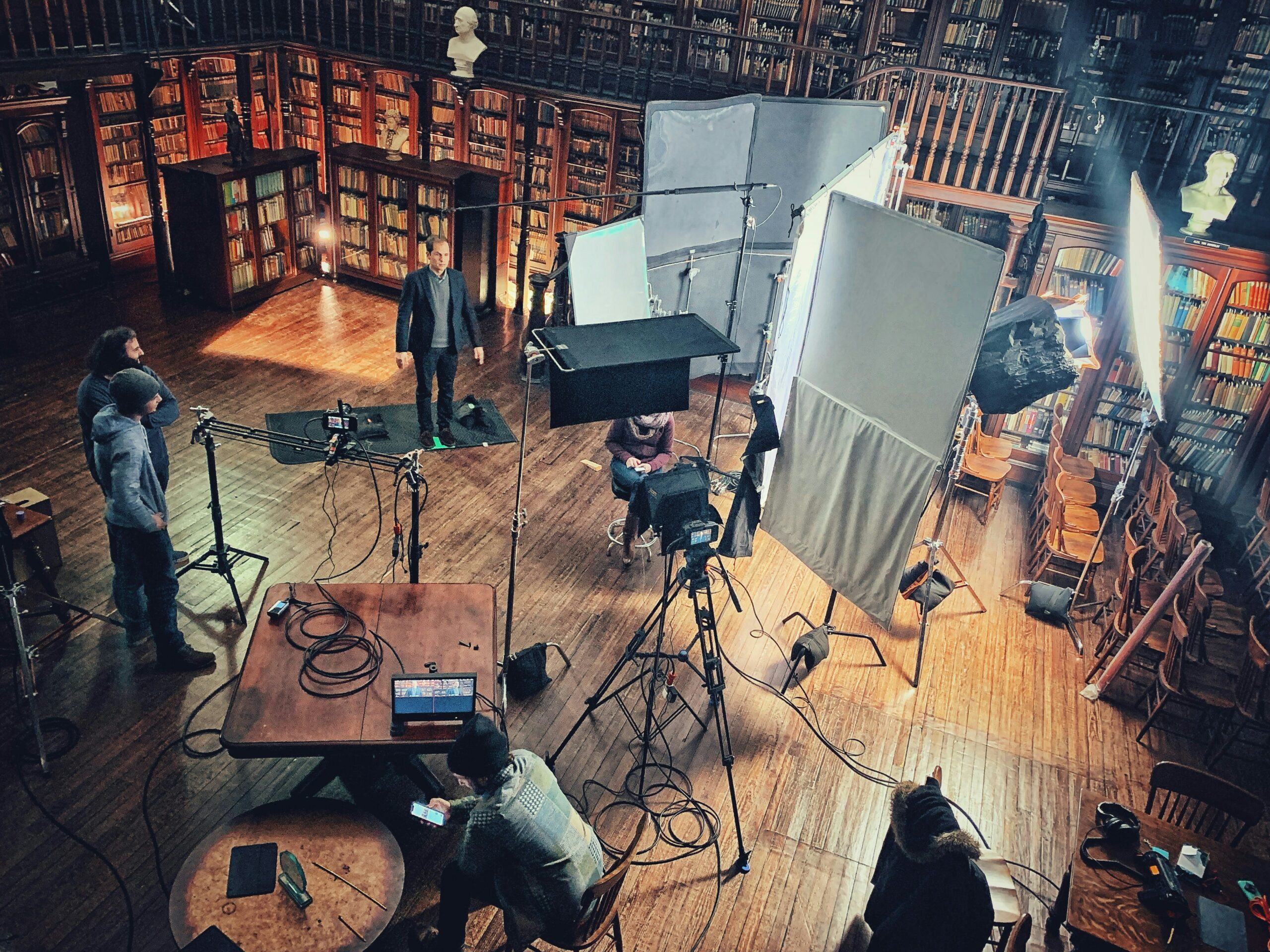The advertising industry is gradually integrating environmental issues into its production processes. Increasingly, the production studios examine their carbon impact and explore solutions to optimize their practices. This approach meets growing customer expectations and is part of a logic of continuous improvement of implementation choices.
Table des matières
The environmental challenges of sector advertising
State of play of the sector
A study conducted by Scope3 in 2023 reveals that digital advertising generates 215,000 tonnes of CO2 emissions each month. This figure only concerns five countries: Germany, the United States, France, Australia and Great Britain. This data illustrates the extent of the environmental impact of the advertising sector, particularly in its digital dimension 🌍
These emissions come from across the advertising value chain: from the creation of content in production studios to its distribution on digital platforms, including storage and distribution infrastructures.
While the environmental impact of advertising is often analyzed on a large scale — via digital campaigns, streaming or ad servers — it is quite different when we get into the behind the scenes of a production studio. Because producing an advertisement is not limited to its broadcast: before appearing on a screen, it passes through physical locations, concrete filming, with very diverse realities.
Filming in a supermarket, a house, a field or a school does not involve the same resources or the same emissions: natural or artificial lighting, power supply, technical travel, logistics… everything varies. This is why production studios represent a special case: a more controllable space, more optimizable — provided that a rigorous environmental approach is implemented.
The role of production studios
Many production studios still use equipment and methods poorly optimized in terms of energy. The main sources of consumption are:
- Computer workstations, such as editing or VFX stations that are continuously on
- Rendering servers, like the internal farms running day and night to generate the images
- Audiovisual equipment, such as control screens, projectors and cameras connected to the mains
Other emission sources also remain avoidable, including:
- travel,
- data storage,
- the dissemination of advertising content.
While a few pioneering studios are already adopting more sustainable practices, the lack of shared standards and measurement tools is hampering large-scale transformation.
Changing customer expectations
Advertisers are gradually integrating environmental criteria in their service provider selection processes. This trend is particularly observed in sectors sensitive to sustainability issues and among companies subject to environmental reporting obligations 📋
Production studios are seeing a growing demand for transparency on their environmental practices. Some clients now request information on the carbon footprint of projects, creating a new criterion for competitive differentiation.
Evolving regulations
The European framework is being strengthened
The European Union is gradually tightening its environmental regulations. The Corporate Social Responsibility Directive (CSRD) now requires large companies to publish their carbon footprint, including their creative service providers.
The Digital Services Act also imposes transparency obligations on the environmental impact of digital services, directly affecting advertising distribution platforms. These new rules push the entire value chain to measure and reduce its emissions 📉
Sectoral initiatives are taking shape
The French advertising industry is organized around charters and environmental labels. The Union of Brands and the AACC (Association of Communication Consulting Agencies) have launched initiatives to structure the sector’s ecological approach.
These organizations encourage the adoption of best practices and the systematic measurement of carbon footprints. They also prepare for the arrival of stricter regulations by encouraging stakeholders to anticipate future obligations.
Best practices to adopt
Optimize energy consumption
Energy efficiency constitutes the first level of action for production studios. The adoption of low-energy equipment, intelligent programming of nighttime renderings, and automatic shutdown of inactive workstations can reduce energy consumption by 30 to 40%.
The use of renewable energies also transforms the carbon footprint. A studio powered by green energy reduces its electricity-related emissions tenfold. Solar panels and green electricity contracts become profitable investments 🌱
Rethinking working methods
Remote working and online collaboration tools drastically reduce travel. Remote approvals, shared footage on cloud platforms, and virtual meetings eliminate many unnecessary trips. Some studios even go further by offering integrated residences to accommodate teams on site, thus reducing the need for daily transport and hotel nights 🏨
Optimized shoot planning allows for grouping shots and minimizing crew travel. A rigorous organization can reduce transport-related emissions by 50%.
But the environmental impact of filming doesn’t stop at travel. Set decoration management, HMC (hair, makeup, and costumes) and catering also plays a key role. Reusing or sharing set elements, favoring recyclable or second-hand materials, means limiting waste and overconsumption. On the HMC side, adopting eco-responsible products and limiting disposables makes all the difference. And for meals, local, seasonal catering in reusable containers can considerably reduce the carbon footprint of a day of filming 🍽️
Manage data intelligently
Selective archiving and automatic deletion of obsolete files free up storage space and reduce server energy consumption. The most advanced studios implement data management policies that eliminate 70% of unnecessary files 💾
Intelligent content compression and format optimization broadcasting techniques reduce the impact of digital distribution. These techniques preserve creative quality while reducing streaming energy consumption by three.
Choosing responsible partners
The selection of committed providers in the ecological transition amplifies the positive impact. Eco-responsible filming platforms, green development laboratories, and carbon-neutral advertising agencies are becoming determining selection criteria.
This collaborative approach creates a virtuous ecosystem where each link in the chain contributes to the overall reduction of the carbon footprint 🔄
Summary of best practices
⚡ Optimize energy consumption
– Low-consumption equipment
– Scheduled night renderings
– Automatic shutdown of the stations
– Use of renewable energies
– Solar panels or green electricity contracts
🚶♀️ Rethinking methods
of work
– Teleworking, validations and remote meetings
– Footage shared online
– Optimized filming planning
– Eco-responsible decorations, HMC and meals
💾 Manage intelligently
the data
– Selective archiving
– Automatic deletion of obsolete files
– Content compression
– Optimization of broadcast formats
🤝 Choose responsible partners
– Eco-responsible platforms, labs, control rooms
– Environmental selection criteria
GreenPro: the measuring tool serving the transition
A solution designed for production studios
Faced with these challenges, our solution GreenPro specifically meets the needs of advertising production studios. This carbon footprint calculation tool integrates the specificities of the creative sector and offers an adapted methodological approach.
GreenPro takes into account all of a studio’s emission stations:
- Energy consumption of equipment
- Team travel
- Impact of digital storage
- Footprint of content dissemination
The tool provides a global and detailed view of environmental impact.
Quick and easy data collection
Our solution automates data collection by being directly connected to the main management tools used by production studios. It also incorporates intelligent invoice recognition technology that automatically extracts the relevant information for carbon calculations.
This automation eliminates tedious manual data entry and guarantees the reliability of the data collected. Bills for electricity, fuel, transport or materials are automatically analyzed and categorized, enabling precise, real-time monitoring of carbon footprints.
Expertise and personalized support
Our team of specialized consultants supports production studios in their environmental optimization efforts. We offer a tailor-made support which ranges from defining the carbon strategy to implementing improvement actions ✅
Our Industry-focused consultants analyze the specificities of each studio and offer concrete solutions adapted to operational constraints. This support includes team training, process optimization and monitoring of results obtained.
Get a personalized demo of our tool!
Towards a more sustainable future
The advertising industry begins its environmental transformation. Production studios, key players in this evolution, now have the tools and methods to reconcile creative excellence and ecological responsibility.
This transition represents a unique opportunity to rethink creative processes and build a more sustainable economic model. Studios that anticipate this movement gain a decisive competitive edge.
The carbon footprint of advertising is no longer inevitable but a challenge to be addressed collectively. Through proper measurement tools and industry-wide commitment, the creative sector can lead by example in sustainable business transformation.





